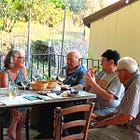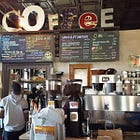Howard Schultz, founder and three-time CEO of Starbucks, has had an epiphany. Instead of running for president, he is turning the tables on billionaires Elon Musk and Mark Zuckerberg by using his fortune to make Starbucks stores the true third places he once imagined and has long promised.
“I don’t need these billions,” he said, “I would rather leave a legacy of coffeehouses that promote democracy and bring people together.”
Schultz and his new team of urbanist activists and democracy demonstrators have peaceably taken the reins at Starbucks. The young team is removing online and drive-through ordering and set up a new in-person welcome system. (This work, Schultz reassures us, is being done systematically and only after careful planning, unlike the DOGE team’s “salt the earth” approach at US federal government offices.) Drive-throughs are being turned into pop-up shops or turned over to local libraries.
Schultz now sheepishly confesses that he took the term third place from sociologist Ray Oldenburg’s famous book, The Great Good Place. “I was full of myself in those days, I admit. I’m embarrassed that I went around saying I’d coined the term. There’s something about getting mega rich that turns your head and I fell into that trap. I’m trying to make amends. I just wish I could apolgize to Oldenburg. Can you believe I sent someone in a limo to impress him, try to get him on board? The old rascal slammed the door when he jumped out.”
The stores themselves will get a complete and sustainable makeover, using existing materials to refigure the layout and make new, larger round “sharing” tables where customers can talk face-to-face.
The new “Sharing Menu” will offer locally baked goods sized for groups. Examples include classic biscuits in southern stores and Norwegian coffee cake in the north. Tables will have trays with milks and sweeteners to encourage interaction, and hosts will have a monthly budget for fresh flowers and greens.
The elimination of wifi and banning of electronics will be gradual. Schultz explains that he has been influenced by The Anxious Generation by Jonathan Haidt. “How can we get kids off their phones if the obvious sign of adulthood is never talking to anyone?”
He has a team consulting with academic phenomenologists to assess the attributes of a coffeehouse’s physical environment that promote social engagement. “Does banning laptops and mobile phones and withdrawing free wifi always result in more face-to-face conversation, or are there other place attributes that need to be added or removed? For example, what is the role of background music and its volume in providing a supportive physical environment?”
Americans are amongst the least socially adept people in the world (only Russians are less capable of enjoying la dolce vita). Schultz sees this as in part the fault of Starbucks. Since many Americans have never talked face-to-face about important issues, selected staff is being trained to facilitate social engagement and offer face-to-face coaching for the shy and for those who only know how to flame in 280 characters.
These “Conversation Concierges” will demonstrate the art of conversation in regionally and seasonally appropriate ways. For example, during the US Open, they will be trained to discuss conversation as serving, volleying, backhand and forehand. Specifics are being worked out for the NFL and hockey seasons. The slow pace of baseball provides appropriate metaphors for some demographic groups. In the UK, cricket is thought to offer special challenges but also opportunity because five-day test matches suggest continuing and regular engagement typical of a third place. A sport that includes a break at teatime and, traditionally, a shared hottub at the end of play is considered by experts a valuable model of social engagement.
The barricades around the baristas are coming down and customers will again be able to watch their coffee being made. The weak American “blond” coffee line will still be offered, but each cup will come with a coupon for a traditional Italian beverage. Instead of an olive-oil infusion, Starbucks is promoting the classic lemon twist with espresso. No longer in paper cups, the coffee will be served in china cups at the correct temperature for full enjoyment.
Most important, says Schultz, is to restore the atmosphere of the early coffee houses, which were called Penny Universities. They offered free newspapers, and using this model Starbucks will be offering a wide range of reading material. “In this time of political division, we need to give customers many ways to get on the same page.”
Click here for the Starbucks third places survey and to comment on reboot plans.
Previously at The Way We Live Now
Affiliate book links go to Bookshop.org, where you can purchase print and ebooks while supporting independent bookshops. Purchases also provide a small payment to Barrington Institute, Berkshire Publishing Group’s sister nonprofit. Any other affiliate link will be indicated and will only be used for items I actually use and recommend. For example, I use Alitu (affiliate link) for our podcasts.













Loved it. I kept wondering when you'd mention the failure of Starbucks to treat its workers fairly. Alas, I do not frequent Starbucks anymore and will not until they allow a unionized workforce. I did appreciate the joke.
That was a mean joke